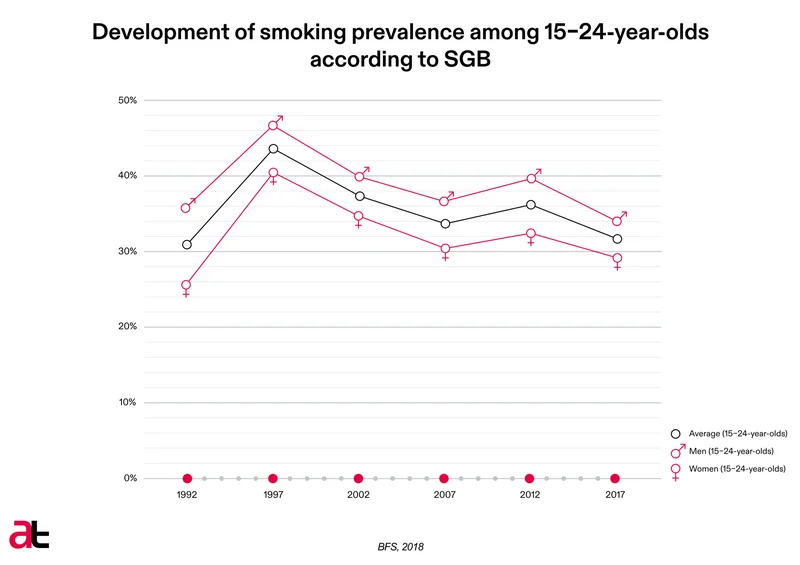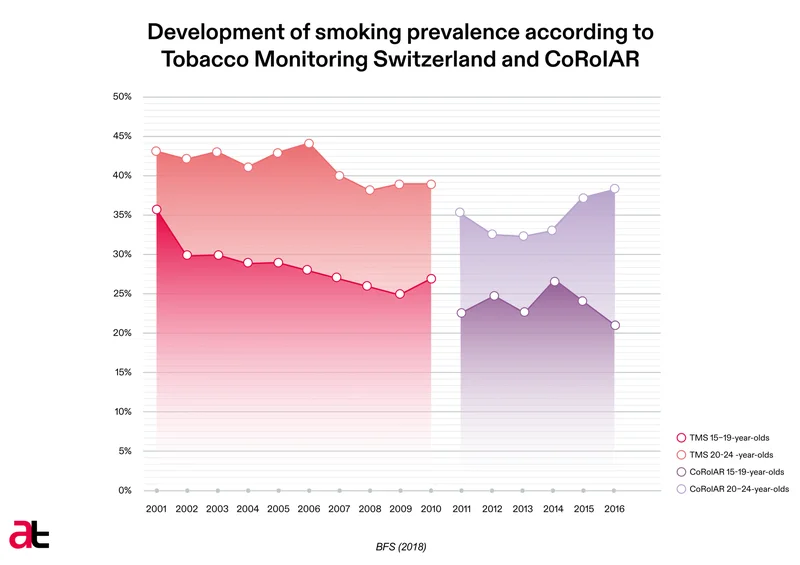Evolution over the past 30 years
- As is the case for the adult population, smoking increased noticeably among young people during the 1990s. Since then, it has diminished somewhat, particularly for 11 to 15-year-olds – to stabilise at its current level.
Even though they are based on very different methodologies, the Swiss health survey (which has been going on since 1992), the studies conducted annually from 2001 to 2018 in the context of the Monitorage suisse sur le tabac (TMS[1]) and of the Monitorage Suisse des addictions (AMIS[2]) as well as the HBSC study (repeated every four years since 1994) allow us to form a fairly precise picture of the changes in tobacco use among young people in Switzerland.
The trends that emerge from these different studies show movement in the same direction over time. They describe, overall, first a significant increase in smoking among young people up to the end of the 1990s, followed by successive small decreases or leveling off in use.
Evolution among schoolchildren 11 to 15 years old
The HBSC study has been following the evolution of tobacco use among schoolchildren 11 to 15 years old since 1986 (Delgrande et al., 2019a[3]). The data presented in this study describe, from 1998 to 2018, clear and relatively uniform tendencies toward a reduction in experimentation with smoking (at least one use; Delgrande et al., 2019a, Figure 3.9, page 74), in weekly cigarette smoking (Delgrande et al, 2019a, Figure 3.10, page 76) and in daily smoking (Delgrande et al, 2019a, Annex 3.17, page 164) for both boys and girls ages 11, 13, and 15 years old. Before this, tendencies toward increasing use, which were also uniform, were observed between 1986 and 1998. For example, in 1998, peaks in experimentation, in at least weekly use, and in daily use were recorded for 15-year-old boys, with more than two-thirds experimenting (68.2%), almost a quarter smoking weekly (24.2%), and almost one-sixth smoking daily (16.4%).
Evolution among adolescents and young adults
The Swiss health survey documents the evolution since 1992 of tobacco consumption for the 15 to 24-year-old age group (Sources OFS, 2018[4]). In this study, the prevalence of tobacco use for all of this age group also showed a significant increase in smoking between 1992 and 1997, at which point it began to show a decrease (Figure A2A-3): the prevalence of smoking thus went from 43.6% in 1997 (46.6% for young men; 40.5% for young women) to 31.7% in 2017 (34.1% for men, 29.2% for young women), with, however, a brief increase between 2007 (33.6%) and 2012 (36.1%).

Figure A1A-E – Changes in the prevalence of smoking (%) between 1992 and 2017 among 14 to 24-year-olds, in total and by sex, ESS 1992-2017 (Sources OFS, 2018[5]).
Evolution among adolescents and young adults since the early 2000s
Over the period between 2001 and 2016, the annual studies dedicated to monitoring tobacco use behavior, which happened regularly in the context of the Monitorage sur le tabac Suisse (TMS) and later the Monitorage Suisse des addictions (CoRolAR study), analysed regularly and in depth the data gathered from adolescents and young adults.
Examining different age sub-groups (14 to 19 and 15 to 19 years old; 14 to 15, 16 to 17, and 18 to 19 years old), the Monitorage sur le tabac Suisse documented, between 2001 and 2010, tendencies toward a reduction of smoking in all groups combined, for women as well as for men (Keller et al., 2011[6]).
Annual data (Gmel et al., 2012-2017[7]) as well as analyses focused on adolescents and young adults in the Monitorage suisse des addictions (Kuendig et al. 2017[8]) suggest that the tendency toward a reduction of smoking among 15 to 19-year-olds and 20 to 24-year-olds during the 2000s, such as was documented by the TMS, did not continue into the period from 2011-2016 (Figure A2A-4). Nevertheless, the Monitorage Suisse des addictions describes different trajectories for these two subgroups: for 15 to 19-year-olds, the prevalence of smoking seems to have increased initially (until 2014), then to have decreased to 21.1% in 2016, whereas for the 20 to 24-year-old age group, smoking was stable, then began to increase in 2015 (to reach 38.2% in 2016 for this age group).

Figure A2A-4 – Changes in the prevalence of smoking (%) among 15 to 19-year-olds and 20 to 24-year-olds based on the studies Monitorage sur le tabac Suisse 2001-2010 and CoRolAR 2011-2015 (Sources Keller et al., 2011[9] and Gmel et al., 2012, 2013, 2014, 2015, 2016, 2017[10]).
Detailed data for the subgroups of 15 to 17, 18 to 19, 20 to 21, 22 to 23, and 24- to 25-year-olds (Kuendig et al., 2017[11]) corroborate the tendencies observed for the 15- to 19- and 20- to 24-year-old age groups (Figure A2A-4). That said, they highlight that while among minors (15 to 17 years) this reduction is mostly due to a lower rate of daily smoking, in the other age subgroups the proportion of daily smokers was stagnant at best during this period. But it has clearly risen for two of the four other subgroups studied (Kuendig et al. 2017[12]; Figure 3.1.3a, page 19).
[1] http://www.tabakmonitoring.ch/; Archive from 10.04.2022.
[2] https://www.suchtmonitoring.ch/fr/page/8.html; accessed 12.02.2022.
[3] Delgrande Jordan, Marina ; Schneider, Eva ; Eichenberger, Yvonne ; Kretschmann, Andrea. (2019a). La consommation de substances psychoactives des 11 à 15 ans en Suisse - Situation en 2018 et évolutions depuis 1986 - Résultats de l'étude Health Behaviour in School-aged Children (HBSC) (Rapport de recherche No 100). Lausanne: Addiction Suisse. Download.
[4] https://www.bfs.admin.ch/bfs/fr/home/statistiques/sante/determinants/tabac.assetdetail.6466022.html; accessed 03.02.2022.
[5] https://www.bfs.admin.ch/bfs/fr/home/statistiques/sante/determinants/tabac.assetdetail.6466022.html; accessed 12.02.2022.
[6] Keller, Roger; Radtke, Theda; Krebs, Hans; Hornung, Rainer (2011): Der Tabakkonsum der Schweizer Wohnbevölkerung in den Jahren 2001 bis 2010. Tabakmonitoring - Schweizerische Umfrage zum Tabakkonsum. Download.
[7] Gmel, Gerhard; Kuendig, Hervé; Notari, Luca; Gmel, Christiane (2017): Monitorage suisse des addictions Consommation d’alcool, de tabac et de drogues illégales en Suisse en 2016. Sucht Schweiz. Lausanne. Download. ; Detailed data are available in the various annual compendiums accessible on the project's publications webpage.
[8] Kuendig, Hervé; Notari, Luca; Gmel, Gerhard (2017). Le tabagisme chez les 15 à 25 ans en 2016 - Analyse des données du Monitorage suisse des addictions. Lausanne : Addiction Suisse. Download.
[9] Keller, Roger; Radtke, Theda; Krebs, Hans; Hornung, Rainer (2011): Der Tabakkonsum der Schweizer Wohnbevölkerung in den Jahren 2001 bis 2010. Tabakmonitoring - Schweizerische Umfrage zum Tabakkonsum. Download.
[10] Gmel, Gerhard; Kuendig, Hervé; Notari, Luca; Gmel, Christiane (2017): Monitorage suisse des addictions Consommation d’alcool, de tabac et de drogues illégales en Suisse en 2016. Sucht Schweiz. Lausanne. Download. ; detailed data available in the different annual collections used to produce this figure, these other collections are accessible on the webpage dedicated to the publications of the link project.
[11] Kuendig, Hervé; Notari, Luca; Gmel, Gerhard (2017). Le tabagisme chez les 15 à 25 ans en 2016 - Analyse des données du Monitorage suisse des addictions. Lausanne : Addiction Suisse. Download.
[12] Kuendig, Hervé; Notari, Luca; Gmel, Gerhard (2017). Le tabagisme chez les 15 à 25 ans en 2016 - Analyse des données du Monitorage suisse des addictions. Lausanne : Addiction Suisse. Download.
AT Switzerland, September 2022